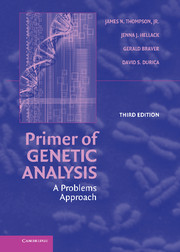Book contents
- Frontmatter
- Contents
- Preface
- Note on Genetic Symbols
- 1 Overview of Genetic Organization and Scale
- 2 Mitosis and Meiosis
- 3 Nucleic Acids: DNA and RNA
- 4 Basic Mendelian Genetics
- 5 Probability and Chi-Square
- 6 Sex-Linkage and Gene Interactions
- 7 Pedigree Analysis
- 8 Overview of Basic Statistical Testing
- 9 Quantitative Inheritance
- 10 Overview of Genetic Mapping
- 11 Assessing Chromosome Linkage Relationships
- 12 Linkage and Mapping in Diploids
- 13 Mapping in Bacteria and Viruses
- 14 Overview of Types of Genetic Change
- 15 Gene Mutation
- 16 Changes in Chromosome Number and Structure
- 17 Protein Synthesis and the Genetic Code
- 18 Gene Regulation and Development
- 19 Overview of Molecular Biology Techniques
- 20 DNA Mapping and Human Genome Analysis
- 21 Basic Population Genetics
- 22 Selection and Evolution
- 23 Practice Tests
- 24 Answers to Practice Tests and Crossword Puzzles
- 25 Landmarks in the History of Genetics
- Glossary
- Reference Tables
8 - Overview of Basic Statistical Testing
Published online by Cambridge University Press: 05 June 2012
- Frontmatter
- Contents
- Preface
- Note on Genetic Symbols
- 1 Overview of Genetic Organization and Scale
- 2 Mitosis and Meiosis
- 3 Nucleic Acids: DNA and RNA
- 4 Basic Mendelian Genetics
- 5 Probability and Chi-Square
- 6 Sex-Linkage and Gene Interactions
- 7 Pedigree Analysis
- 8 Overview of Basic Statistical Testing
- 9 Quantitative Inheritance
- 10 Overview of Genetic Mapping
- 11 Assessing Chromosome Linkage Relationships
- 12 Linkage and Mapping in Diploids
- 13 Mapping in Bacteria and Viruses
- 14 Overview of Types of Genetic Change
- 15 Gene Mutation
- 16 Changes in Chromosome Number and Structure
- 17 Protein Synthesis and the Genetic Code
- 18 Gene Regulation and Development
- 19 Overview of Molecular Biology Techniques
- 20 DNA Mapping and Human Genome Analysis
- 21 Basic Population Genetics
- 22 Selection and Evolution
- 23 Practice Tests
- 24 Answers to Practice Tests and Crossword Puzzles
- 25 Landmarks in the History of Genetics
- Glossary
- Reference Tables
Summary
In earlier chapters, such as Chapter 5, we discussed probability and statistics as they apply to a specific kind of genetic problem. Here we want to take a more general view of biostatistics and introduce some of the different ways one can describe relationships and test hypotheses.
The term statistics refers to the mathematical process of collecting, analyzing, interpreting, and presenting numerical data. Some statistical measures are purely descriptive, such as the sample mean or values of dispersal like the range, standard deviation, and variance. Other statistical measures are designed to evaluate relationships among groups of data or to test hypotheses about them.
Some descriptive statistics important in genetic analyses are discussed in more detail in Chapter 9, which focuses on quantitative genetic traits. Many quantitatively varying traits, such as seed number and tail length, approximate a normal distribution. The mean is the average value for a data set, and the variance is a measure of dispersal around the mean. The standard deviation is the square root of the variance and divides a normal distribution into subgroups of known size (for example, 68 percent of the data points fall within one standard deviation of the mean, 95 percent fall within two standard deviations, and 99 percent fall within three).
In describing relationships within and among the data points, it is useful to distinguish between two general types of statistical tests. Parametric statistic tests assume a normal distribution of the data; nonparametric statistics do not.
- Type
- Chapter
- Information
- Primer of Genetic AnalysisA Problems Approach, pp. 84 - 86Publisher: Cambridge University PressPrint publication year: 2007

